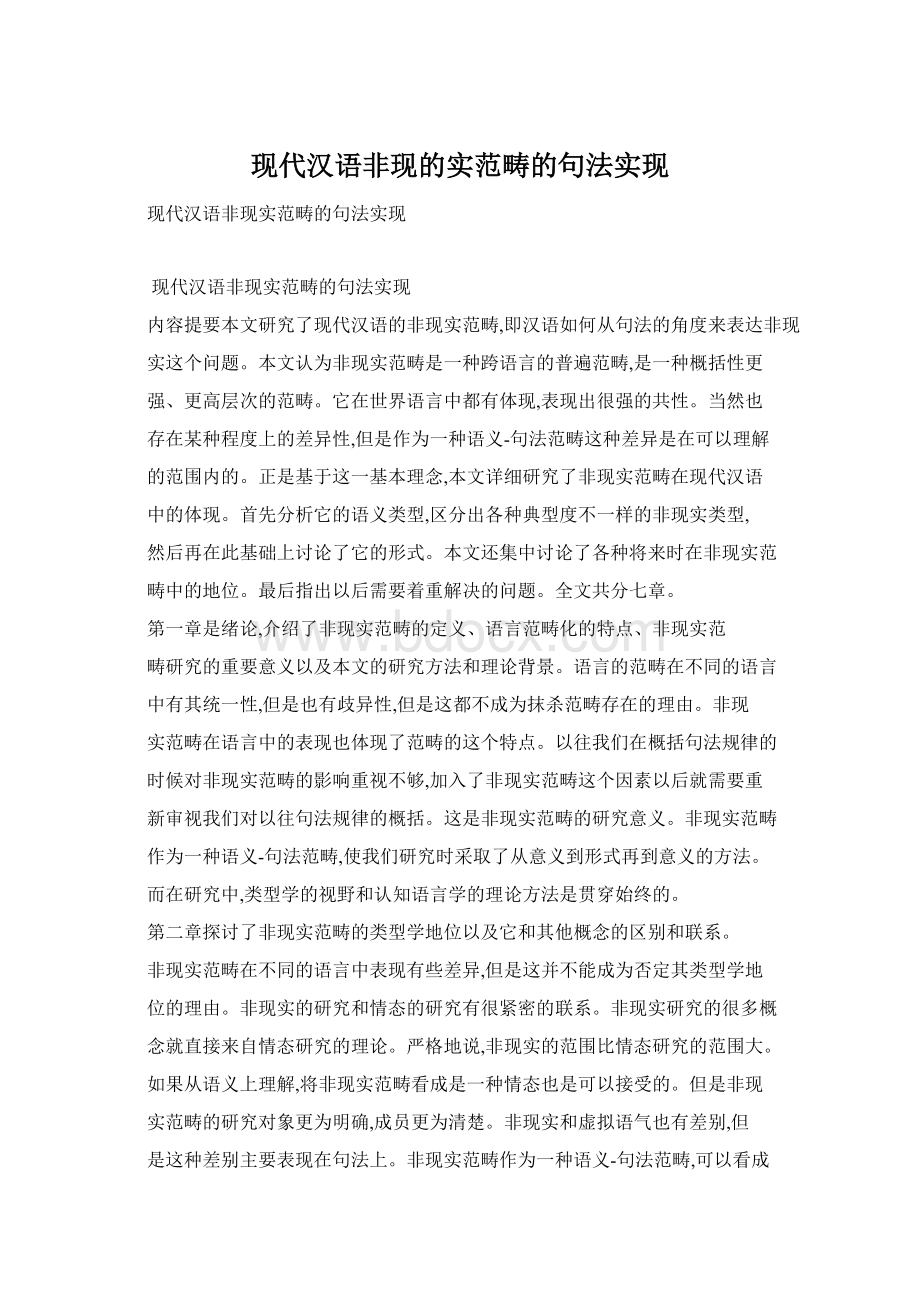现代汉语非现的实范畴的句法实现.docx
《现代汉语非现的实范畴的句法实现.docx》由会员分享,可在线阅读,更多相关《现代汉语非现的实范畴的句法实现.docx(15页珍藏版)》请在冰豆网上搜索。

现代汉语非现的实范畴的句法实现
现代汉语非现实范畴的句法实现
现代汉语非现实范畴的句法实现
内容提要本文研究了现代汉语的非现实范畴,即汉语如何从句法的角度来表达非现
实这个问题。
本文认为非现实范畴是一种跨语言的普遍范畴,是一种概括性更
强、更高层次的范畴。
它在世界语言中都有体现,表现出很强的共性。
当然也
存在某种程度上的差异性,但是作为一种语义-句法范畴这种差异是在可以理解
的范围内的。
正是基于这一基本理念,本文详细研究了非现实范畴在现代汉语
中的体现。
首先分析它的语义类型,区分出各种典型度不一样的非现实类型,
然后再在此基础上讨论了它的形式。
本文还集中讨论了各种将来时在非现实范
畴中的地位。
最后指出以后需要着重解决的问题。
全文共分七章。
第一章是绪论,介绍了非现实范畴的定义、语言范畴化的特点、非现实范
畴研究的重要意义以及本文的研究方法和理论背景。
语言的范畴在不同的语言
中有其统一性,但是也有歧异性,但是这都不成为抹杀范畴存在的理由。
非现
实范畴在语言中的表现也体现了范畴的这个特点。
以往我们在概括句法规律的
时候对非现实范畴的影响重视不够,加入了非现实范畴这个因素以后就需要重
新审视我们对以往句法规律的概括。
这是非现实范畴的研究意义。
非现实范畴
作为一种语义-句法范畴,使我们研究时采取了从意义到形式再到意义的方法。
而在研究中,类型学的视野和认知语言学的理论方法是贯穿始终的。
第二章探讨了非现实范畴的类型学地位以及它和其他概念的区别和联系。
非现实范畴在不同的语言中表现有些差异,但是这并不能成为否定其类型学地
位的理由。
非现实的研究和情态的研究有很紧密的联系。
非现实研究的很多概
念就直接来自情态研究的理论。
严格地说,非现实的范围比情态研究的范围大。
如果从语义上理解,将非现实范畴看成是一种情态也是可以接受的。
但是非现
实范畴的研究对象更为明确,成员更为清楚。
非现实和虚拟语气也有差别,但
是这种差别主要表现在句法上。
非现实范畴作为一种语义-句法范畴,可以看成
是比虚拟范畴更大的范畴。
本章还介绍了汉语学界对汉语是否有反事实范畴的
讨论。
最后本章介绍了非现实范畴理论和心理空间理论的区别和联系,二者的
研究对象有重合的地方,但是并不是完全一样。
第三章针对非现实范畴在世界语言中表现出来的差异性进行研究,证明这
样的歧异性是可以理解的,非现实范畴在语言中还是表现出了很强的统一性。
本章首先说明了非现实范畴是一个更有解释力的范畴,能够解释像时态这样的
范畴所难以回答的问题。
在非现实范畴的范畴化中,认知距离起到了很大的作
7现代汉语非现实范畴的句法实现
用。
对将来时态和其他的成分都有影响。
本章根据认知语言学的理论,首先确
定了非现实的原型,再在此基础上归纳出了原型的特点。
然后看看其他非现实
类型的相似性程度。
在此基础上我们概括了非现实范畴的具体差异性表现,并
从范畴化差异、中间状态、标记辖域、部分与整体、社会接受因素等方面作了
说明。
第四章在参照形式的基础上研究了现代汉语中非现实范畴的语义系统。
在
介绍了汉语学界对非现实范畴、非现实句的争论之后,我们提出了我们对非现
实范畴的看法,即非现实范畴在汉语中是一个语义-句法范畴,所以它的各种表
现不是在一个平面上的。
我们应该区分不同层面上的非现实,即要注意区分情
态层面的非现实和语气层面的非现实。
在说明本文的目标是研究情态层面的非
现实,即非现实的句法实现以后,我们给出了非现实句的形式化判定标准。
这
使得我们将大量不是非现实范畴的句子区分开来。
根据我们在第三章对非现实
的原型特点的归纳,我们找出了现代汉语中各种非现实范畴的下位类型,研究
它们和原型的相似性程度。
在此基础上我们逐个论述了认识情态、义务情态、
传信情态、潜势情态、习惯体等各种典型和非典型的非现实范畴。
发现从典型
的非现实范畴到不典型的非现实范畴是一个连续统,所以我们对成员不可能作
出非此即彼的划分。
最后本章厘清了汉语对非现实的某些争议,还提出了对汉
语情态、主观性和句类的思考。
第五章研究非现实范畴在现代汉语中的形式表现。
首先我们说明,非现实
范畴不仅跨越不同的语言层面,还是在形式上具有多样性,这种多样性正是汉
语的特点。
本章依次介绍了汉语中的非现实范畴的语法表现,即情态动词、情
态副词、时态副词、虚指语、带从句的动词以及复句结构。
本章对非现实表现
形式最为重要的两种即情态动词和情态副词的区分作了论述。
在分析了前人对
情态动词的鉴定方法和得出的范围之后,认为必须依靠一个核心意义来确定情
态动词的范围。
这个核心意义就是非现实。
在分析情态动词时,我们将情态动
词的各个语义进行了分析,认为情态动词在典型性上也有高低。
在分析情态副
词时我们穷尽了汉语的情态副词。
并对情态动词和情态副词的区分作了比较深
入的探讨,认为情态副词和情态动词最重要的区别是在于是否表现了语言的限
定形式,其他的区别都由此而来的。
在对情态副词的分类后,我们给出了从动
词-情态动词-句内情态副词-句外情态副词-语气词的连续统。
本章还具体论述
了将来副词“将”表现非现实的情况。
虚指语表现非现实的情况,它们和认知
距离有关,是认知的可及性语法化的结果。
从句法的角度上还分析了带从句的
动词构成的句子以及复句。
这是作为第四章判断标准的补充。
第六章研究了将来时间和非现实范畴的关系。
涉及两个方面的问题,一是
将来时态的非现实地位问题;二是否定标记和非现实的关系。
我们认为将来时
8现代汉语非现实范畴的句法实现
虽然表示未发生的事件,其特征和表现手段还是比较复杂的。
本文认为将来时
作为一种范畴有如下特点:
情态性、表现多样性、出现时间晚、非可证明性等
几个特点。
本文认为汉语也有时态这个语法范畴,汉语中的将来时态分为近时
将来时和远时将来时,它们的非现实性程度是不一样的,远时将来更典型。
而
且,将来时的不同的标记的典型度也不一样。
除了将来时态标记,说话人对将
来事件的现实非现实的看法也影响着说话人对句法结构的选择。
当表示计划好
的近时将来或迫在眉睫的将来事件时,说话人倾向于选择现实时而不是将来时
标记来表达,因为说话人把这样的将来事件看成是现实。
本章还论述了否定标
记“不”的特点,认为“不”是非现实范畴的否定标记,表现了时间的通指性
特征。
在否定半非现实范畴时并不是唯一的选择。
由于“不”的特点,它还进
一步语法化,具有了假设的作用。
第七章是本文的结论和余论。
指出了今后需要着重研究的问题。
关键词:
非现实范畴句法实现情态语气认知距离认识情态义务情态
情态动词情态副词将来时连续统典型度9现代汉语非现实范畴的句法实现
10现代汉语非现实范畴的句法实现
AbstractThispaperisastudyonIrrealisinmodernChinese,namelyonhowIrrealisis
expressedsyntacticallyinChinese.Asacrosslinguisticuniversalcategory,Irrealisis
moreconclusiveandinhigherlevel.It’sembodiedinWorld’slanguagesandshows
greatuniversalities.Therearesomediscrepanciesamonglanguagesbutasa
semantic-syntacticcategory,it’squiteunderstandable.Basedonthisconcept,this
paperthoroughlyresearchesthesyntacticalrealizationofIrrealisinChinese.Weat
firstanalyzeitssemanticalsub-categoriesandconcludedifferentIrrealistypeswith
differenttypicality.ThentheformsofIrrealisareexplored.Wealsoexploreallkinds
offuturetensesandtheirstatusinIrrealis.Attheendofthepaper,wepointoutthe
issuestobeaddressedinthefuture.TherearesevenchaptersinthispaperChapteroneisintroduction.ItintroducesthedefinitionofIrrealis,the
characteristicsoflinguisticcategorization,thesignificanceofIrrealisstudyandthis
paper’sapproachandtheoreticalbackground.Linguisticcategoryhasits
universalitiesanditsdiscrepanciesamonglanguages,butitcannobethereasonto
denytheexistenceofthecategory.Irrealisisnoexception.Intheprevioussyntactic
study,wedidn’tpayenoughattentiontotheinfluenceofIrrealis.Weshould
re-examinesomesyntacticalconclusionsifIrrealisistakenintoaccount.Thisisthe
significanceofIrrealisstudy.BecauseIrrealisisasemantical-syntacticalcategory,
weadoptfrommeaningtoformandthenbacktomeaningapproach,withTypology
asourperspectiveandCognitiveLinguisticsasourtheoreticalbackgroundthrough
outourstudyChaptertwodiscussesthetypologicalstatusofIrrealisanditsdifferenceand
connectionwithotherterms.Itsdiscrepanciesinlanguagescan’tnegateits
typologicalstatus.ThereisacloseconnectionbetweenIrrealisstudyandModality
studyaswecanseethatmanyterminologiesofIrrealiscomefromModalitystudyStrictlyspeaking,thescopeoftargetofIrrealisiswiderthanthemodality’sSemantically,it’sacceptabletoconsiderIrrealisasakindofmodality.ButIrrealisis
morecircumscribed.IrrealisisalsodifferentfromSubjunctivemood,especiallyon
syntacticalaspect.SinceIrrealisisasemantical-syntacticalcategory,itcanbe
consideredasabiggercategorythanSubjunctivemood.Thischapteralsointroduces
thedebateonwhetherChinesehascounter-factualcategoryinChineselinguistics11现代汉语非现实范畴的句法实现
society.Inthefinalpartofthischapter,wediscusstherelationbetweenIrrealis
theoryandMentalSpaceTheory.Therearesuperpositionsbetweenthetwotheories
buttheyaredifferentChapterthreeisaimedtodiscrepanciesofIrrealisshowninlanguages,proving
thediscrepanciesareunderstandableandIrrealishasstronguniversalitiesin
languagesThischapteratfirstdemonstratestheIrrealisisamoreconclusive
categoryanditcanexplainsomedifficultphenomenawhichTensecan’t.Italso
showthatinthecategorizationofIrrealis,cognitivedistanceplaysaimportantrole
init,influencingfuturetenseandotherelements.BasedonCognitiveTheory,this
chapteridentifiestheprototypeofIrrealis,hencethecharacteristicsareconcludedso
astocheckthesimilaritiesbetweentheprototypeandothertypesofIrrealis.Wealso
surveyalldiscrepanciesamonglanguagesandexplainitfromtheangleof
categorizationdegree,intermediatestate,thescopeofmarkers,partsandentireness,
thesocialfactors,etcWithreferencefromforms,chapterfourexploresthesemanticsystemof
IrrealisinmodernChinese.AfterintroducingthecontroversyonIrrealiscategory
andIrrealissentencesinChineselinguisticssociety,weputforwardouropinion
aboutIrrealis:
asasemantical-syntacticalcategory,Irrealiscanberealizedin
differentlevelsofalanguage.SoweshoulddistinguishIrrealisindifferentlevels,
namelytheIrrealisinModalitylevelandinMoodlevel.Afterspecifyingour
researchtarget,namelythesyntacticalrealizationofIrrealis,weputforwardour
formalcriteriononjudgingwhetherasentenceisanIrrealissentence.Soitmakes
possibletoexcludenon-IrrealissentencesfromIrrealissentencesBasingonthecharacteristicswesummarizeinChapterthree,wesurveyall
sub-categoriesofIrrealis,inordertocomparethemwiththeprototypeofIrrealis.We
studyallsub-categoriesofIrrealisonebyone,fromEpistemicIrrealis,Deontic
Irrealis,EvidentialIrrealis,PotentialityIrrealis,toHabitual.Wefindoutthatitisa
continuumfromtypicalIrrealistoatypicalIrrealis.Soitishardtomakeaclearcut
betweenthem.Attheendofthischapter,weclarifysomeideasaboutChinese
IrrealisresultingfromsomedebatesandweelaborateourreflectionsaboutChinese
modalities,subjectivityandsentencetypesChapterfiveisastudyonallkindsofformsofIrrealisinChinese.Firstofall,
Irrealisnotonlycrossesdifferentlevelsofthelanguage,butalsohasdiversityof
formsexpressingIrrealis,whichisatraitofChineseIrrealis.Thischapterexamines
allformsexpressingIrrealis,inlcudingmodalverbs,modaladverbs,expletivewords,12现代汉语非现实范畴的句法实现
clauseverbsandcompoundsentences
Thischapterfocusesalargepartondistinguishingmodalverbsandadverbs
whicharemostimportantformsexpressingIrrealis.Aftersurveyingthe
identificationmethodsandresultofmodalverbsinthepreviousliterature,we
suggestweshoulduseacoremeaningtodefinetherangeofmodalverbs.Thatis
Irrealis.Onmodalverbs,weanalyzeallmeaningofmodalverbsandsuggestmodal
verbsshowdifferentdegreeoftypicality.Asformodaladverbs,wethoroughly
investigateallmodaladverbs.Thedifferencesbetweenmodalverbsandmodal
adverbsarethendiscussed,hencethemostimportantdifferenceisrevealed:
modal
verbcarrythefiniteformofverbsbutmodaladverbsnot.Afterclassifyingall
adverbs,weputforwardthecontinuum:
verb-modalverb-internalmodaladverb-
externalmodaladverb-moodwordsThischapteralsostudiesthefuturetensemarker“Jiang”.Italsoexamineshow
expletivewordsarerelatedtoIrrealis.Itfindsoutthatitisrelatedtocognitive
distanceandtheresultofcognitiveaccessibility.Clauseverbsandcompound
sentencesarealsostudiedfromaspectofsyntacticsconcerningIrrealisChaptersixstudiestherelationbetweenfuturetimeandIrrealis.Itinvolvestwo
issues.ThefirstisabouttheIrrealisstatusoffuturetense.Thesecondisaboutthe
relationbetweennegationmarkersandIrrealis.Wesuggestalthoughfuturetense
describesthoseeventsthatarenottakenplace,itscharacteristicsandformsare
complicated.Wethinkithasfollowingcharacteristics:
modality,diversityofforms,
lateemergenceandbeyondevaluation.Afterconfirmingtheexistenceoffuturetense
inChinese,wedividefuturetense